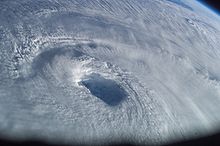Eye (meteorology)

In meteorology, an eye is the almost windless center of a cyclone .
If the tropical cyclone rotates fast enough, an eye can form. The eye is a relatively cloud-free, weak wind area around the center of rotation, in which cold, dry air sinks down from above. In exceptional cases, an eye can be up to 320 km in diameter, but the average diameter is less than 50 km. Surrounded the eye of high-reaching cumulus clouds, which is eye Wall (eng .: Eyewall ). The tropical cyclone reaches the highest wind speeds in this zone.
Since the storm also has an additional proper motion that is added to the rotation speed, the main wind field is always on the side where the rotation and the proper motion point in the same direction. Example: If a cyclone moves north with a rotation speed of 200 km / h in the northern hemisphere, rotating counterclockwise with an own speed of 30 km / h, the total speed at the eastern wall of the eyes is 230 km / h. On the western side, on the other hand, only 170 km / h is reached, since here the natural movement works against the rotational movement.
